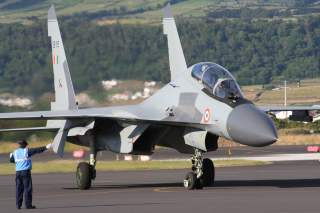India's Su-30 Jets Are Now Armed With Nuclear BrahMos Cruise Missiles
What happens when the world’s most capable fourth generation fighter is armed with a uniquely destructive cruise missile?
Key Point: The Brahmos-armed Su-30s is only one of the ways that India is strengthening its strategic deterrent.
India’s nuclear command has begun receiving fighter jets armed with the country’s most advanced, supersonic cruise missile.
According to media reports, India’s Strategic Forces Command (SFC) has begun receiving 42 Su-30MKI air dominance fighters modified to carry air-launched BrahMos supersonic cruise missile. This will significantly enhance the striking power of the air leg of India’s nuclear triad.
“Individually, the Su-30 and BrahMos are powerful weapons,” Russia and India Report noted. “But when the world’s most capable fourth generation fighter is armed with a uniquely destructive cruise missile, together they are a dramatic force multiplier.”
The Sukhoi Su-30 MKI is a twin-seater, highly maneuverable, fourth-generation multirole combat fighter aircraft built by Russia’s Sukhoi Design Bureau and licensed to India’s Hindustan Aeronautics Limited. The plane will serve as the backbone of India’s Air Force through 2020 and beyond. Delhi has already acquired around 200 jets, and eventually plans to acquire 282 of them.
The Brahmos is jointly developed by India’s Defense Research and Development Organization (DRDO) and Russia’s NPO Mashinostroeyenia. Capable of traveling at speeds of Mach 3.0, the Brahmos is the fastest cruise missile in the world. As Russia and India Report explained, “The BrahMos’ 3000 km per second speed – literally faster than a bullet – means it hits the target with a huge amount of kinetic energy. In tests, the BrahMos has often cut warships in half and reduced ground targets to smithereens.”
The same report notes that the Su-30 will add to the Brahmos’ already deadly effect. “The Sukhoi’s blistering speed will add extra launch momentum to the missile, plus the aircraft’s ability to penetrate hardened air defences means there is a greater chance for the pilot to deliver the missile on to its designated targets.”
Pairing the Su-30 with the Brahmos missile will also drastically expand the striking power of the air leg of India’s nuclear triad. The Su-30 itself has a range of up to 1,800 kilometers while the Brahmos missile can strike targets nearly 300 kilometers away. Thus, the newly modified Su-30s will allow India’s nuclear aircraft to strike deep in the heart of China or Pakistan, Delhi’s two main adversaries.
The plan to modify the Su-30 to carry the Brahmos missiles was first hatched back in 2010 when the SFC submitted a proposal for two squadrons of Su-30s to be put under its command. Later, in 2012, India’s cabinet approved the project to modify 42 Su-30s to carry 216 Brahmos missiles. According to the Times of India, the integration project was mostly carried out by BrahMos Aerospace, with HAL also contributing crucial modifications.
The first of the new planes was handed over to the SFC in February and is believed to have undergone tests last month. Production on the second of the modified Su-30s has already begun. It is unclear when the SFC expects to receive the rest of the planes.
The Brahmos-armed Su-30s is only one of the ways that India is strengthening its strategic deterrent. It has also been busy testing the Agni-V, which is three-stage solid-fueled intermediate-range ballistic missile (IRBM) with a range of about 5,000 km. When the Agni-V is inducted into service, India will have the ability to strike any part of China with nuclear weapons for the first time. Furthermore, India is currently testing ballistic missile submarines (SSBN), which will complete the nuclear triad.
Zachary Keck is a former managing editor of The National Interest. You can find him on Twitter: @ZacharyKeck.
This article originally appeared in April 2015. It is being republished due to reader interest.
Image: Jerry Gunner via Flickr.
Recommended:
Why North Korea's Air Force is Total Junk

